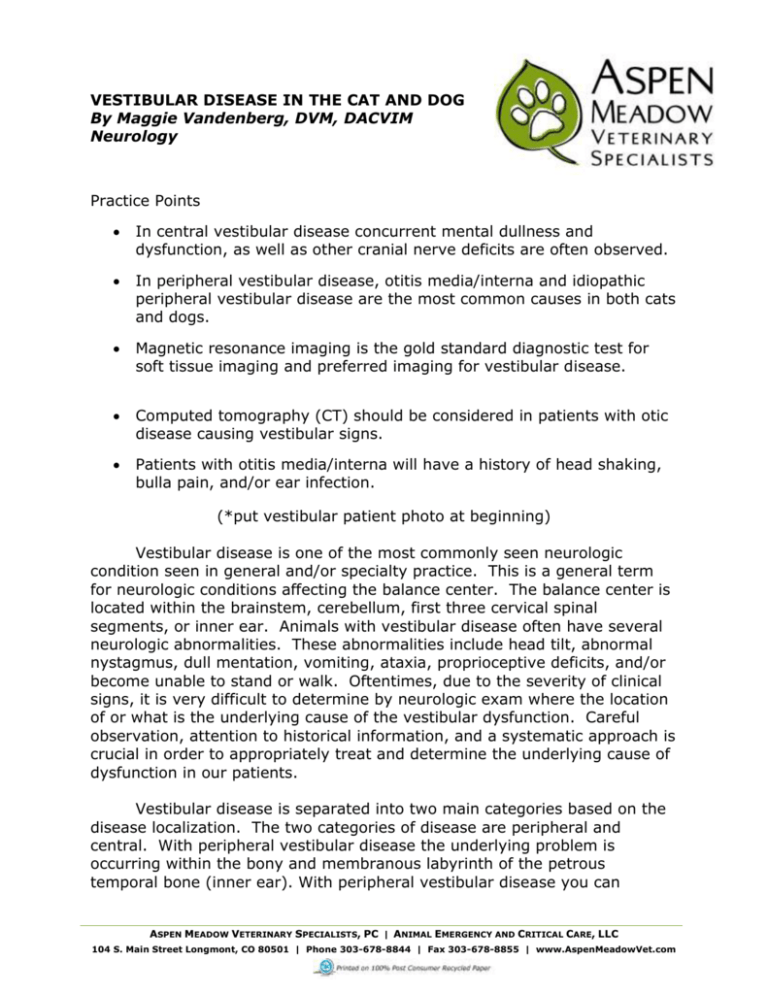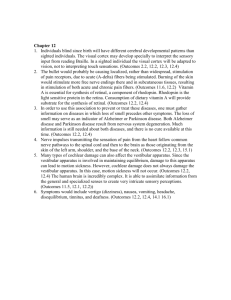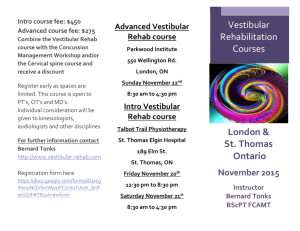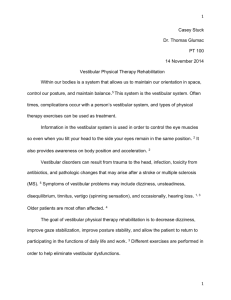05.13 VV Vestibular Disease by MV - Aspen Meadow Vets
advertisement

VESTIBULAR DISEASE IN THE CAT AND DOG By Maggie Vandenberg, DVM, DACVIM Neurology Practice Points In central vestibular disease concurrent mental dullness and dysfunction, as well as other cranial nerve deficits are often observed. In peripheral vestibular disease, otitis media/interna and idiopathic peripheral vestibular disease are the most common causes in both cats and dogs. Magnetic resonance imaging is the gold standard diagnostic test for soft tissue imaging and preferred imaging for vestibular disease. Computed tomography (CT) should be considered in patients with otic disease causing vestibular signs. Patients with otitis media/interna will have a history of head shaking, bulla pain, and/or ear infection. (*put vestibular patient photo at beginning) Vestibular disease is one of the most commonly seen neurologic condition seen in general and/or specialty practice. This is a general term for neurologic conditions affecting the balance center. The balance center is located within the brainstem, cerebellum, first three cervical spinal segments, or inner ear. Animals with vestibular disease often have several neurologic abnormalities. These abnormalities include head tilt, abnormal nystagmus, dull mentation, vomiting, ataxia, proprioceptive deficits, and/or become unable to stand or walk. Oftentimes, due to the severity of clinical signs, it is very difficult to determine by neurologic exam where the location of or what is the underlying cause of the vestibular dysfunction. Careful observation, attention to historical information, and a systematic approach is crucial in order to appropriately treat and determine the underlying cause of dysfunction in our patients. Vestibular disease is separated into two main categories based on the disease localization. The two categories of disease are peripheral and central. With peripheral vestibular disease the underlying problem is occurring within the bony and membranous labyrinth of the petrous temporal bone (inner ear). With peripheral vestibular disease you can ASPEN MEADOW VETERINARY SPECIALISTS, PC | ANIMAL EMERGENCY AND CRITICAL CARE, LLC 104 S. Main Street Longmont, CO 80501 | Phone 303-678-8844 | Fax 303-678-8855 | www.AspenMeadowVet.com additionally observe ipsilateral dysfunction of the post-ganglionic sympathetic innervation to the eye, and/or dysfunction in cranial nerve VII. In central vestibular disease the underlying problem is occurring within the brain (brainstem, cerebellum) or first three cervical spinal cord segments. With central vestibular disease concurrent mental dullness and dysfunction in other cranial nerves (cranial nerves V, VII, IX, XII) is often observed. Cats and dogs have very different etiologies of vestibular dysfunction. Peripheral vestibular disease has many underlying causes. The two most common causes of peripheral vestibular dysfunction in both species include: otitis media/interna and idiopathic peripheral vestibular disease. Patients with otitis media/interna will have a history of head shaking, bulla pain, and/or otic discharge/infection. Otic examination will be abnormal. If there are not any apparent abnormalities on otic examination than another cause should be sought out. It is very important to recognize that topical otic medications can be extremely ototoxic especially when the integrity of the tympanic membrane is compromised. So ideally they should not be used at all. Additionally, horner syndrome or facial nerve paralysis is commonly seen along with otitis media/interna as these nerves pass within the inner ear in close association with the vestibular receptors. Idiopathic vestibular disease is seen in both cats and dogs. In both species it’s onset is acute and clinical signs (head tilt, ataxia, vomiting) can be quite severe. In this disorder cranial nerve VII and/or horner syndrome will not be seen. It is seen in dogs over 5 years of age and can occur in cats of any age. Aural neoplasms are seen in both species and tend to be more malignant (85% of the time) in cats. Nasopharygeal polyps are found in young cats (1-5 years of age). They are usually unilateral and removal by traction polypectomy through the mouth or external ear canal typically results in a 30-40% recurrence rate. A bulla osteotomy can reduce recurrence to ~10%. Hypothyroidism is a condition that causes peripheral cranial neuropathy in dogs. Commonly cranial nerves VII and VIII are affected together. Supplementation with thyroid hormones usually results in improvement within a few months. Central vestibular disease should definitely be considered if proprioceptive deficits, dull mentation, and/or other brainstem signs are observed. These conditions are often more insidious and/or chronic in nature. They can be acute though with cerebrovascular disease. Conditions that cause central vestibular dysfunction are hypothyroidism (dog), intracranial tumors, non-infectious inflammatory disease (granulomatous meningoencephalitis), infectious disease (fungal, protozoal, viral, rickettsial), metronidazole toxicity (dogs), metabolic diseases (portosystemic shunts, hypothyroidism), cerebrovascular disease (more commonly in the dog), and degenerative diseases (lysosomal storage diseases). Work up for both forms of vestibular disease is similar. Getting a baseline blood chemistry, complete blood count, urinalysis, and blood pressure is essential in every patient. Typically patients are not in a lifethreatening situation and taking the time to adequately assess your patient is essential. Supportive therapy should be initiated as soon as possible. Typically patients have vertigo and may be vomiting. In these patients it is recommended to start intravenous fluid support, anti-emetics, and appropriate nursing (turning, passive range of motion, supported ambulation). Steroids are not indicated in the initial nursing period. In many instances they are not necessary and if given they will interfere with future diagnostic testing (i.e., cerebrospinal fluid analysis, magnetic resonance imaging). If an otic infection is confirmed, appropriate testing (myringotomy, culture, cytology) and administration of antibiotic therapy should be performed. In the persistently hypertensive patient, underlying causes of hypertension should be sought out. Testing such as protein:creatinine, ACTH stimulation test, abdominal ultrasound, +/echocardiography can be considered if indicated by the laboratory results and initial assessment. If the initial diagnostics do not reveal an underlying cause, a neurologic consultation should be performed. At that time magnetic resonance imaging (MRI) of the brain (FIGURE 1) +/- cerebrospinal fluid (CSF) analysis should be considered. Computed tomography (CT) (FIGURE 2) could be considered for otic disease causing only peripheral signs but is not ideal in patients with central vestibular disease. With CT, the beam hardening artifacts caused by the bone can preclude visualization of small lesions within the brainstem, cerebellum. Thus MRI is the preferred method of imaging for vestibular disease as it is the gold standard diagnostic test for soft tissue imaging.







